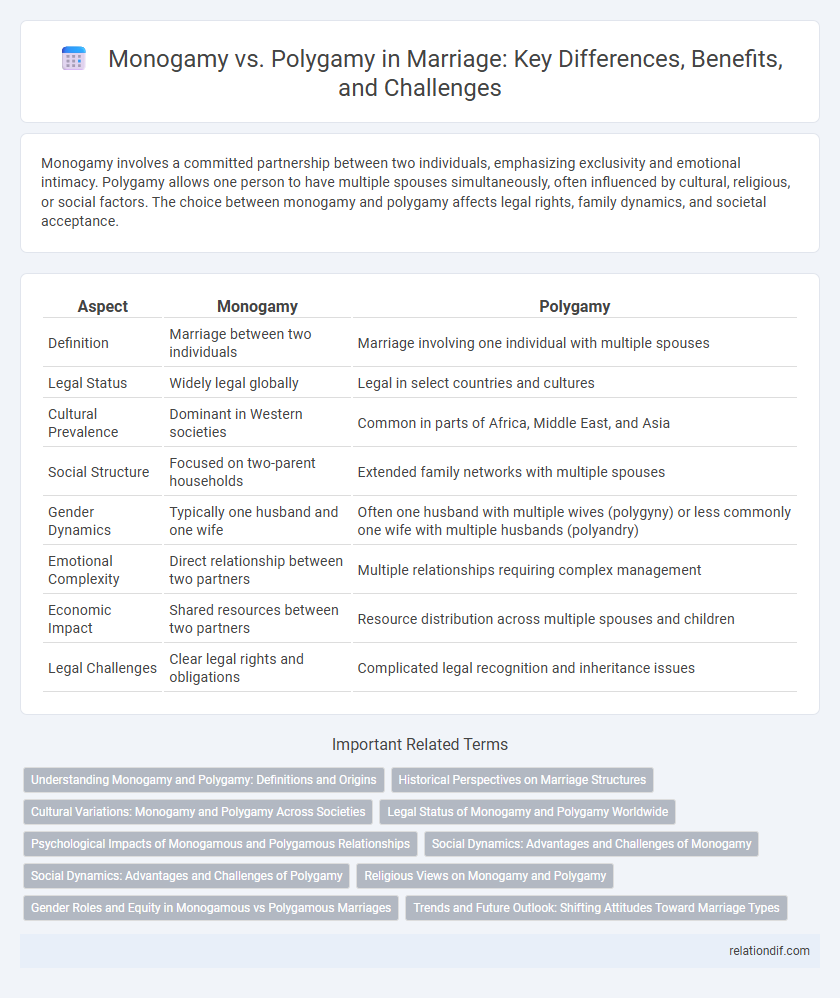Monogamy involves a committed partnership between two individuals, emphasizing exclusivity and emotional intimacy. Polygamy allows one person to have multiple spouses simultaneously, often influenced by cultural, religious, or social factors. The choice between monogamy and polygamy affects legal rights, family dynamics, and societal acceptance.
Table of Comparison
| Aspect | Monogamy | Polygamy |
|---|---|---|
| Definition | Marriage between two individuals | Marriage involving one individual with multiple spouses |
| Legal Status | Widely legal globally | Legal in select countries and cultures |
| Cultural Prevalence | Dominant in Western societies | Common in parts of Africa, Middle East, and Asia |
| Social Structure | Focused on two-parent households | Extended family networks with multiple spouses |
| Gender Dynamics | Typically one husband and one wife | Often one husband with multiple wives (polygyny) or less commonly one wife with multiple husbands (polyandry) |
| Emotional Complexity | Direct relationship between two partners | Multiple relationships requiring complex management |
| Economic Impact | Shared resources between two partners | Resource distribution across multiple spouses and children |
| Legal Challenges | Clear legal rights and obligations | Complicated legal recognition and inheritance issues |
Understanding Monogamy and Polygamy: Definitions and Origins
Monogamy refers to a marital structure where an individual has only one spouse at a time, originating from cultural, religious, and legal traditions emphasizing exclusivity and partnership. Polygamy involves having multiple spouses simultaneously and is historically rooted in various societies for social, economic, or demographic reasons. Understanding the definitions and origins of monogamy and polygamy reveals the diverse ways human relationships are organized and regulated across cultures.
Historical Perspectives on Marriage Structures
Historical perspectives on marriage structures reveal that monogamy emerged predominantly in Western societies influenced by Roman law and Christian doctrine, emphasizing exclusive pair bonding. In contrast, polygamy has been historically practiced in many African, Middle Eastern, and Indigenous cultures, often linked to social, economic, and reproductive strategies. Anthropological evidence shows that polygamous arrangements facilitated alliance-building and resource distribution, while monogamy promoted inheritance clarity and nuclear family stability.
Cultural Variations: Monogamy and Polygamy Across Societies
Monogamy predominates in Western societies, emphasizing exclusive partnerships often linked to legal and religious frameworks, while polygamy remains culturally significant in regions of Africa, the Middle East, and parts of Asia, where it is integrated within social and economic structures. Anthropological studies reveal that polygamous arrangements vary from polygyny to less common polyandry, reflecting diverse cultural norms and inheritance practices. These variations highlight how marriage forms adapt to environmental, economic, and social factors, shaping family dynamics and community relationships worldwide.
Legal Status of Monogamy and Polygamy Worldwide
Monogamy is legally recognized and enforced in the majority of countries, establishing a single-spouse marriage as the standard marital framework. Polygamy is legally permitted or tolerated in specific regions, particularly within parts of Africa, the Middle East, and Asia, often influenced by cultural and religious practices. International human rights laws increasingly promote monogamy to ensure gender equality and legal clarity in marital rights and obligations.
Psychological Impacts of Monogamous and Polygamous Relationships
Monogamous relationships often foster deeper emotional intimacy and stability, leading to increased psychological well-being and reduced stress levels. In contrast, polygamous relationships can introduce complex dynamics such as jealousy, competition, and resource allocation challenges, which may elevate anxiety and emotional strain. Research highlights that individual experiences vary widely, with cultural context playing a significant role in moderating the psychological impacts of both relationship types.
Social Dynamics: Advantages and Challenges of Monogamy
Monogamy fosters stable social bonds and clearer inheritance lines, which can enhance trust and cooperation within communities. It simplifies legal frameworks concerning marital rights, custody, and property, reducing potential conflicts. Challenges include addressing individual desires for multiple partnerships, which may lead to social tensions or emotional dissatisfaction in strictly monogamous societies.
Social Dynamics: Advantages and Challenges of Polygamy
Polygamy influences social dynamics by creating complex family structures that can offer economic stability and extended social support networks. Challenges arise from potential conflicts over resources, emotional strain among spouses, and societal stigma in cultures favoring monogamy. These dynamics necessitate effective communication and legal frameworks to manage relationships and ensure equity within polygamous marriages.
Religious Views on Monogamy and Polygamy
Religious views on marriage often shape attitudes toward monogamy and polygamy, with Christianity predominantly endorsing monogamy based on biblical teachings such as those found in Ephesians 5:31, which emphasize the union of one man and one woman. In contrast, Islam permits polygamy under specific conditions, allowing a man to marry up to four wives provided he can treat them with justice and equality, as stated in the Quran (Surah An-Nisa 4:3). Judaism traditionally supports monogamy but historically allowed polygamy in certain contexts, though most contemporary Jewish communities now practice monogamous marriage.
Gender Roles and Equity in Monogamous vs Polygamous Marriages
Monogamous marriages often promote more equal gender roles by encouraging shared responsibilities and emotional intimacy between partners, fostering a sense of partnership and fairness. In contrast, polygamous marriages can reinforce traditional gender hierarchies, where male authority is emphasized and women may have less autonomy and equitable decision-making power. Studies indicate that gender equity tends to be higher in monogamous relationships due to the balanced distribution of resources, emotional labor, and social status among spouses.
Trends and Future Outlook: Shifting Attitudes Toward Marriage Types
Shifting attitudes toward marriage reveal a gradual increase in acceptance of diverse marital structures, with monogamy remaining predominant in most societies but polygamy gaining consideration in certain cultural contexts. Demographic studies indicate younger generations prioritize personal fulfillment and flexibility, leading to evolving trends in relationship dynamics and legal frameworks. Future outlooks suggest continued dialogue around marriage definitions, influenced by globalization, technological advancements, and changing social norms.
monogamy vs polygamy Infographic

 relationdif.com
relationdif.com